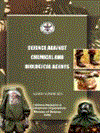|
|
|
Sort Order |
|
|
|
Items / Page
|
|
|
|
|
|
|
| Srl | Item |
| 1 |
ID:
120189


|
|
|
|
|
| Publication |
New Delhi, DRDO, 2009.
|
| Description |
x,132p.pbk
|
| Series |
DRDO Monograph Series
|
| Standard Number |
9788186514283
|
|
|
|
|
|
|
|
|
|
|
|
Copies: C:1/I:0,R:0,Q:0
Circulation
| Accession# | Call# | Current Location | Status | Policy | Location |
| 057250 | 358.3/SEN 057250 | Main | On Shelf | General | |
|
|
|
|
| 2 |
ID:
153740


|
|
|
|
|
| Summary/Abstract |
The authors analyze the achievements of the world leading countries in creating filtering protective materials for individual skin protection against weapons of mass destruction damaging factors.
|
|
|
|
|
|
|
|
|
|
|
|
|
|
|
|
| 3 |
ID:
132370


|
|
|
|
|
| Publication |
2014.
|
| Summary/Abstract |
Today, the specters of lone wolves and autonomous cells acquiring and using chemical, biological, radiological, and nuclear (CBRN) weapons of mass destruction, whether in their traditional military forms or the more non-traditional industrial forms, seems less far-fetched. Fortunately, military CBRN agents and weapons are not normally accessible to lone wolves or autonomous cells and are often located in highly secured areas. Therefore, lone wolves and autonomous cells may be drawn to materials similar to CBRN located in less secure areas. These commonplace industrial chemicals, biological contaminants, and radioactive materials could be used to cause disruptions or mass casualties. The dual use nature of these materials and technologies enables them to be turned into weapons and delivered by nonmilitary means. Future "over-the-horizon" threats, such as the proliferation of new biotechnologies and amateur do-it-yourself capabilities, pose a risk that lone wolves could develop weapons at a time when travel, access to knowledge, and dual-use technologies, in the globalizing environment, make lone wolf terrorists more dangerous. Thus, the author explores existing countermeasures, such as laws, strategies, passive and active measures designed to stop these dangerous threats. In particular, capabilities to prevent, protect, respond, and recover from CBRN terrorist acts are examined.
|
|
|
|
|
|
|
|
|
|
|
|
|
|
|
|
|
|
|
|
|